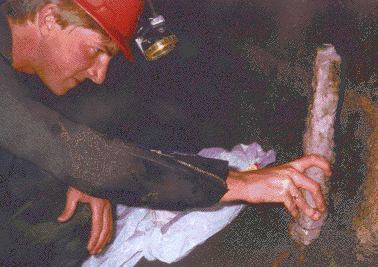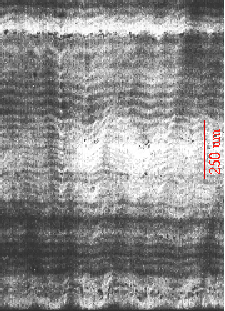
Dr. Michael T. Murrel and Dr. David A. Pickett
Los Alamos National
Laboratory
This research investigates the past climatic changes in the Midwest during the last 10,000 years. The isotopes of carbon and oxygen in the calcite of stalgmites are being used to detect:
This information can be combined with that obtained by paleontologists studying fossil pollen and plant remains to perform detailed reconstructions of past climates.
We are now attempting to analyze yearly growth layers of calcite. This will allow a very detailed climatic reconstruction.
The information obtained by this study will be helpful to persons studying climate. It will help in the prediction of the effects of "global warming" in the Midwest.

This study is utilizing stalagmites from Cold Water Cave located approximately 3 miles northwest of Bluffton, in Winneshiek County northeastern Iowa. Detailed information on vegetation changes in Iowa has been obtained by Dr. R.G. Baker and colleagues in Robert's Creek, Clear Lake, and Lake West Okaboji.

Cold Water Cave lies more than 30 meters (nearly 100 feet) below the surface and its natural entrance is through a series of water filled sumps. A 76 centimeter (30 inches) shaft drilled by the Iowa Geological Survey in 1971 provides access to the cave. There are approximately 8 kilometers of main passage, and over 22 kilometers total passage. Three stalagmites were temporarily removed from the cave, the central portion was carefully cored, and the stalagmites were returned to the cave.

Jeffrey A. Dorale returns one of the stalagmites to its original position. All three stalagmites were returned to their original position. Stalagmites are actively growing again.

This image, obtained by using a Laser Scanning Confocal Microscope at the Control Electron Microscope Facility of The University of Iowa, reveals annual growth layers in the stalagmites. The difference in "dark" and "light" zones are controlled by solar activity, and the thickness of the bands is controlled by the amount of rain. By analyzing individual layer coloration and thickness, we hope to be able to resolve detailed changes in temperature and precipitation in the 10,000 years.

The isotopes of carbon and oxygen reveal that the present climatic condition in northeastern Iowa (Stage 3) started about 3,600 years ago. Between 3,600 and 5,900 years ago, the vegetation was predominately prairie, the mean annual temperature was 3 degrees (C) warmer. The sharp change in oxygen isotopes suggest that climatic conditions changed in less than 50 years! From 5,900 to over 8,000 years ago conditions were similar to present, though warmer by approximately 1 degree (C).
Return to Coldwater Cave Research page